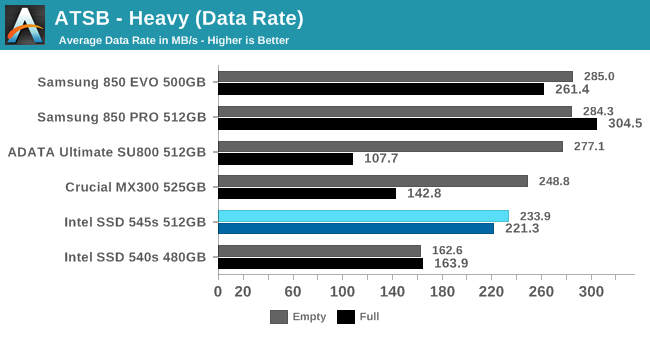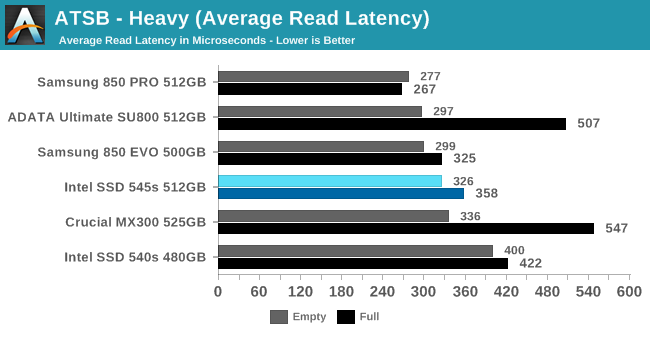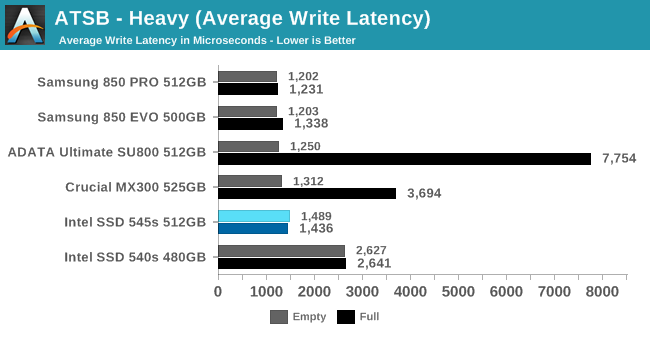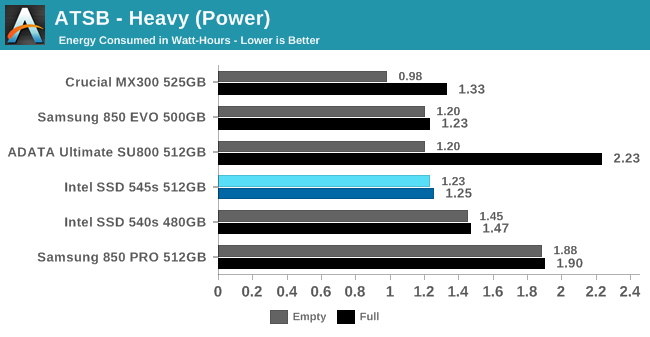The Intel SSD 545s (512GB) Review: 64-Layer 3D TLC NAND Hits Retail
by Billy Tallis on June 27, 2017 6:00 AM ESTAnandTech Storage Bench - Heavy
Our Heavy storage benchmark is proportionally more write-heavy than The Destroyer, but much shorter overall. The total writes in the Heavy test aren't enough to fill the drive, so performance never drops down to steady state. This test is far more representative of a power user's day to day usage, and is heavily influenced by the drive's peak performance. The Heavy workload test details can be found here. This test is run twice, once on a freshly erased drive and once after filling the drive with sequential writes.

The Intel SSD 545s shows substantial improvement over the 540s in average data rates for the Heavy test. The 545s is not quite able to compete against Samsung as was the case for The Destroyer, but it comes much closer than its predecessor.
The 545s also fares far better when the test is run on a full drive than the drives that use the previous generation 32L 3D TLC (ADATA's SU800 and Crucial's MX300). Both of those drives beat the 545s when the test is run on an empty drive, but suffer a huge performance loss when the drive is full.

The latency measurements for the Intel 545s on the Heavy test tell a similar story to the average data rates. Intel is now in the same league as the other 3D NAND SSD, though still in last place. When the test is run on a full drive, the Crucial and ADATA drives fall apart and average latency spikes to the 2–4ms range while the latency of the Intel 545s is unaffected and remains well below 1ms.


The read latency of the older Intel 540s is not too far behind the 3D NAND drives and it handles being full with no trouble, but its write latency in either case is almost twice as high as the 3D NAND drives. The biggest improvement of the Intel 545s comes from cutting that write latency. The read latency also improved enough to surpass the Crucial MX300.

The energy usage of the Intel 545s during the Heavy test has it essentially tied for second place with the Samsung 850 EVO, while the Crucial MX300 has the clear lead when the test is run on an empty drive. The MX300's advantage disappears when the test is run on a full drive and the SU800's energy usage almost doubles.










74 Comments
View All Comments
Billy Tallis - Tuesday, June 27, 2017 - link
I expect it'll be M.2 2280 for all the same capacities, though the 2TB M.2 would probably have to be double-sided. If Intel does a shorter M.2 version it'll more likely be sold as the OEM or embedded model.Rictorhell - Tuesday, June 27, 2017 - link
Thank you for your reply. Yeah, I am looking for a shorter model with a higher capacity than what is currently available. You have given me some hope that something that suits my needs may be released.Glock24 - Tuesday, June 27, 2017 - link
Nice to finally see a competitor to the 850Evo. Hopefully it's not overly expensive.Over at Storagereviews they experienced lockups due to firmware:
"Unstable firmware that causes SSD and attached system to lock under certain repeatable conditions"
Was your experience similar?
Billy Tallis - Tuesday, June 27, 2017 - link
I haven't experienced any lock-ups from the 545s yet, but I would expect the synthetic tests to be more likely to trigger something like that.tigz1218 - Tuesday, June 27, 2017 - link
Can someone explain to me why they still make these? Isn't m2 the better solution with 3,000mbs read/write?I am a noob so please go easy, thanks!
A5 - Tuesday, June 27, 2017 - link
These are cheaper and there are still a ton of computers that don't have M.2 slots.Vast majority of the market doesn't really need something that totally saturates SATA.
tigz1218 - Tuesday, June 27, 2017 - link
Cool thank you. I figured it was due to something like that.I noticed that difference in price between m2 and SSD isn't as drastic as when SSDs first came out compared to disc drives. Wondering if that means we will see m2 get adopted at a faster rate.
Thanks again :)
Kwarkon - Friday, June 30, 2017 - link
Hi there, you mean NVME SSD that use usually x4 PCIe with m.2 form factor.Because in fact there are also m.2 SATA SSD that perform and cost the same as 2.5" SATA SSD.
fanofanand - Tuesday, June 27, 2017 - link
How is M.2 more expensive? It's less hardware, I would assume it's vastly cheaper. They just charge more because it's still "new", but I fail to see how adding the enclosure etc. reduces cost.Tadashi130 - Tuesday, June 27, 2017 - link
Finding a way to route all connections on a smaller PCB is much harder.